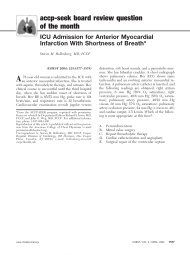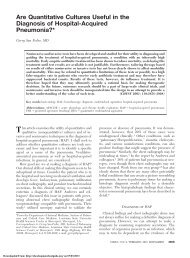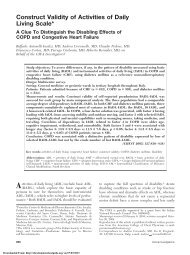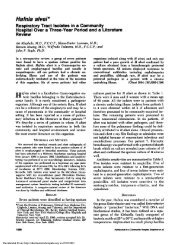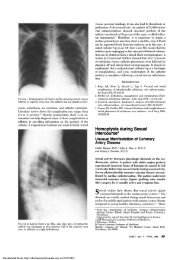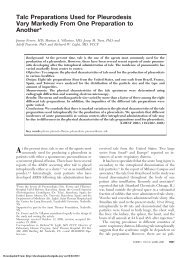The Effects of Corticotropin (ACTH) and Cortisone in Fifteen Cases ...
The Effects of Corticotropin (ACTH) and Cortisone in Fifteen Cases ...
The Effects of Corticotropin (ACTH) and Cortisone in Fifteen Cases ...
You also want an ePaper? Increase the reach of your titles
YUMPU automatically turns print PDFs into web optimized ePapers that Google loves.
<strong>The</strong> <strong>Effects</strong> <strong>of</strong> <strong>Corticotrop<strong>in</strong></strong> (<strong>ACTH</strong>) <strong>and</strong> <strong>Cortisone</strong><br />
<strong>in</strong> <strong>Fifteen</strong> <strong>Cases</strong> <strong>of</strong> Pulmonary Tuberculosis*<br />
EUGENE J. DES AUTELS, M.D., F.C.C.P., JAMES R. ZVETINA, M.D.,<br />
GEORGE S. BERG, M.D., JENNINGS FERSHING, M.D.<br />
<strong>and</strong> SMITH FREEMAN, PH.D., M.D.<br />
H<strong>in</strong>es, Ill<strong>in</strong>ois<br />
Despite numerous studies reported dur<strong>in</strong>g the past six years, the controversy<br />
concern<strong>in</strong>g the effects <strong>of</strong> <strong>ACTH</strong> <strong>and</strong> cortisone on tuberculous<br />
<strong>in</strong>fections cont<strong>in</strong>ues. When one considers the many known <strong>and</strong> unknown<br />
factors that <strong>in</strong>fluence host-parasite relationships, the different reactions<br />
<strong>of</strong> different species to tuberculous <strong>in</strong>fections, <strong>and</strong> the varied effects <strong>of</strong><br />
different drugs <strong>and</strong> hormones on the <strong>in</strong>fect<strong>in</strong>g organism, the persist<strong>in</strong>g<br />
controversy is not surpris<strong>in</strong>g.<br />
Adm<strong>in</strong>istration or exogenous <strong>ACTH</strong> stimulates <strong>in</strong>creased production<br />
<strong>of</strong> not only catabolic glucocorticoids, such as hydrocortisone <strong>and</strong> cortisone,<br />
but also anabolic <strong>and</strong>rogenic <strong>and</strong> estrogenic “N” hormones <strong>and</strong> m<strong>in</strong>eral<br />
corticoids.<br />
In contrast to <strong>ACTH</strong>, the adm<strong>in</strong>istration <strong>of</strong> exogenous cortisone or<br />
hydrocortisone may <strong>in</strong>crease the blood level <strong>of</strong> the hormone given but<br />
otherwise reduces the endogenous production <strong>of</strong> the anabolic “N” hormones<br />
<strong>and</strong> m<strong>in</strong>eral corticoids as well as adrenal glucocorticoids. Hydrocortisone<br />
or cortisone therapy will also suppress the pituitary gl<strong>and</strong> <strong>and</strong> its production<br />
<strong>of</strong> <strong>ACTH</strong>, TSH, gonadotrop<strong>in</strong>, etc. <strong>and</strong> thereby secondarily reduce<br />
the production <strong>of</strong> adrenocortical, thyroid, sex, <strong>and</strong> other hormones.<br />
<strong>ACTH</strong> therapy stimulates hypertrophy <strong>of</strong> the adrenal cortex <strong>and</strong> <strong>in</strong>creased<br />
endogenous production <strong>of</strong> many adrenocortical hormones, whereas<br />
cortisone or hydrocortisone therapy results <strong>in</strong> atrophy <strong>of</strong> the adrenal cortex<br />
(dim<strong>in</strong>ished <strong>ACTH</strong> stimulation) <strong>and</strong> reduced endogenous production <strong>of</strong><br />
adrenocortical hormones.<br />
Thus cortisone therapy more grossly alters the over-all normal hormonal<br />
balance <strong>and</strong> <strong>in</strong>terferes with more factors affect<strong>in</strong>g host-resistance to stress<br />
or <strong>in</strong>fection, than does <strong>ACTH</strong> therapy, because <strong>of</strong> deficencies <strong>of</strong> endogenous<br />
production <strong>of</strong> many more hormones. <strong>The</strong>oretically, at least, these differences<br />
would suggest that <strong>ACTH</strong> might be less harmful than cortisone <strong>in</strong> <strong>in</strong>fections.<br />
<strong>Fifteen</strong> cases <strong>of</strong> active pulmonary tuberculosis were selected for complete<br />
metabolic studies <strong>of</strong> <strong>ACTH</strong> <strong>and</strong> cortisone, <strong>and</strong> the <strong>in</strong>fluence <strong>of</strong> these hormones<br />
upon toxic manifestations. However, because <strong>of</strong> the cont<strong>in</strong>u<strong>in</strong>g<br />
uncerta<strong>in</strong>ty, confusion, <strong>and</strong> disagreement among equally reliable <strong>in</strong>vestigators<br />
who have used hormonal therapy <strong>in</strong> tuberculosis, a report <strong>of</strong><br />
*From the Tuberculosis Service <strong>and</strong> Research Division, Veterans Adm<strong>in</strong>istration<br />
Downloaded From: http://chestioumal.chestpubs.org/ on 07/03/2013<br />
Hospital.<br />
With the technical assistance <strong>of</strong> Joanna X. Wheeler, B. S. <strong>and</strong> Eugene Kanabrocki, B.S.<br />
486
vol. xxx <strong>ACTH</strong> AND CORTISONE IN TUBERCULOSIS 487<br />
co<strong>in</strong>cidental cl<strong>in</strong>ical, roentgenologic, <strong>and</strong> selected laboratory observations<br />
noted <strong>in</strong> this study seems worthwhile.<br />
Case Material (Background Factors)<br />
All patients were male veterans with proved active pulmonary tuberculosis.<br />
Seven were less than 40 years <strong>of</strong> age, <strong>and</strong> eight ranged from 44 to<br />
57 years. Eight were white, six negro, <strong>and</strong> one was Indian. <strong>The</strong> disease<br />
was far advanced <strong>in</strong> 14 cases <strong>and</strong> moderately advanced <strong>in</strong> one (3). Cavities<br />
were present <strong>in</strong> 13 <strong>of</strong> the 15 cases <strong>and</strong> were 2.0 to 10.0 cm. <strong>in</strong> diameter <strong>in</strong><br />
12 (Table I). <strong>The</strong> known duration <strong>of</strong> disease was six months or less <strong>in</strong><br />
n<strong>in</strong>e cases, <strong>and</strong> from one to more than four years <strong>in</strong> four.<br />
Eight had received chemotherapy for periods <strong>of</strong> three to 10 months.<br />
Bacilli from six <strong>of</strong> the eight cases were completely resistant to 10 meg. <strong>of</strong><br />
streptomyc<strong>in</strong> per ml. <strong>and</strong> partially resistant <strong>in</strong> two. Two had received<br />
chemotherapy for one month <strong>and</strong> two <strong>and</strong> one-half months respectively,<br />
<strong>and</strong> partial bacillary resistance was noted <strong>in</strong> each case. Tests <strong>of</strong> bacillary<br />
Case No. Age Race<br />
TABLE I<br />
BACKGROUND FACTORS BEFORE HORMONAL THERAPY<br />
Stage<br />
<strong>of</strong><br />
Dis.<br />
Dur.<br />
<strong>of</strong><br />
Cavity Di,.<br />
(Cm.) (Mo,.) Drugs’<br />
Our.<br />
(Mos.)<br />
l3act.<br />
Resist.<br />
To SM<br />
1. 29 N F. A. 2.5 3 DHSM 1 .... Station.<br />
2. 22 N F. A. 0.0 2 None 0 ... Station.<br />
3. 45 W M. A. 0.0 1 None 0 .... Unknown<br />
4. 28 N F. A. 2.5 15 SM 3 CR2 Station.<br />
5. 39 W F. A. 2.0 6 SM + PAS 4 CR Progress.<br />
6. 55 N F.A. 7.0 6 SM + PAS 5 PR2 Retrogr.<br />
7. 52 W F. A. 3.0 6 DHSM + PAS 2’/2 PR Progress.<br />
8. 57 W F. A. 6.5 4.5 SM + PAS 1 PR Progress.<br />
9. 30 W F. A. 4.5 21 (SM alone<br />
(PAS alone<br />
3<br />
7<br />
X-ray<br />
Changes<br />
Pre-Rx<br />
CR Retrogr.<br />
10. 54 Ind. F.A. 9.5 5+ None 0 . Unknown<br />
11.<br />
12.<br />
44<br />
23<br />
N<br />
N<br />
F.A.<br />
F. A.<br />
0.5<br />
7.0<br />
7<br />
1.5<br />
SM<br />
SM<br />
+ PAS 4<br />
V2<br />
CR<br />
.<br />
Progr.<br />
Retrogr.<br />
Station.<br />
then<br />
13. 57 W F.A. 10.0 10 DHSM+PAS 3V2 PR Progress.<br />
14. 34 W F. A. 10.0 52<br />
15. 50 W F. A. 9.0 21<br />
Downloaded From: http://chestioumal.chestpubs.org/ on 07/03/2013<br />
SM+PAS<br />
(DHSM alone 3<br />
(PAS alone 3<br />
(SM+PAS r,,<br />
CR Progress.<br />
CR Progress.<br />
(1) <strong>The</strong> dosage <strong>of</strong> streptomyc<strong>in</strong> (SM) <strong>and</strong> dihydrostreptomyc<strong>in</strong> (DHSM) was one<br />
gram daily <strong>in</strong> all patients except three (Nos. 5, 6 <strong>and</strong> 8) who received one gram<br />
twice weekly. <strong>The</strong> dosage <strong>of</strong> PAS was 12.0 gms. daily.<br />
(2) Completely resistant (CR) <strong>and</strong> partially resistant (PR) to 10 meg. <strong>of</strong> SM per ml.
488 DES AUTELS ET AL November. 1956<br />
susceptibility to streptomyc<strong>in</strong> were lack<strong>in</strong>g <strong>in</strong> five cases. Of the latter five<br />
cases, two had received chemotherapy for 14 days <strong>and</strong> 28 days respectively<br />
<strong>and</strong> three had received no chemotherapy prior to hormonal therapy (Table<br />
I). (Only one (3) <strong>of</strong> the latter three cases received chemotherapy concurrently<br />
with hormonal therapy).<br />
Serial roentgenograms, before hormonal therapy (Table I) revealed<br />
progression <strong>of</strong> disease <strong>in</strong> six cases, progression then retrogression <strong>in</strong> one<br />
90<br />
70<br />
-.2<br />
00 50-<br />
30-<br />
10.<br />
90.<br />
70.<br />
U)<br />
x 50.<br />
*<br />
001<br />
30.<br />
WV,<br />
2<br />
U)<br />
105-<br />
104-<br />
103-<br />
isls -<br />
101.<br />
I00<br />
9$.6. :<br />
98.<br />
Downloaded From: http://chestioumal.chestpubs.org/ on 07/03/2013<br />
10.<br />
-<br />
HORMONAL THERAPY<br />
IN PULMONARY TUBERCULOSIS<br />
0 I<br />
CONTROL PERIOD MONTHS<br />
FIGURE 1: Case 1 (C. B.). This case illustrates the typical sharp defervescence <strong>of</strong><br />
fever (representative <strong>of</strong> cl<strong>in</strong>ical response) <strong>in</strong> patients who received <strong>ACTH</strong> therapy.<br />
Twenty-four hour ur<strong>in</strong>ary excretion <strong>of</strong> 17-ketosteroids <strong>in</strong>dicates <strong>ACTH</strong> effect. Note<br />
lack <strong>of</strong> concurrent chemotherapy. Dosage <strong>of</strong> hormone ma<strong>in</strong>ta<strong>in</strong>ed at unnecessarily<br />
high level too long <strong>and</strong> stopped too abruptly. Sharp return <strong>of</strong> high fever <strong>and</strong> toxic<br />
symptoms upon discont<strong>in</strong>uation <strong>of</strong> <strong>ACTH</strong> therapy suggests “rebound phenomenon.”<br />
(Also see Fig. 2).<br />
1<br />
2
Vol. XXX <strong>ACTH</strong> AND CORTISONE IN TUBERCULOSIS 489<br />
(11), no change <strong>in</strong> three, retrogression <strong>in</strong> two, <strong>and</strong> the roentgenographic<br />
course <strong>of</strong> the disease was unknown <strong>in</strong> the two cases started on hormonal<br />
therapy shortly after admission.<br />
Regimen <strong>of</strong> <strong>The</strong>rapy<br />
<strong>The</strong> details <strong>of</strong> drugs, dosages, <strong>and</strong> duration <strong>of</strong> chemotherapy given <strong>in</strong><br />
each case before, dur<strong>in</strong>g <strong>and</strong> after hormonal therapy, appear <strong>in</strong> Tables<br />
I, II <strong>and</strong> III respectively. <strong>The</strong> type <strong>of</strong> hormonal therapy given <strong>in</strong> each case<br />
appears <strong>in</strong> Table II. In general the earlier cases were started at a dosage<br />
<strong>of</strong> 100 or 80 mgs. <strong>of</strong> <strong>ACTH</strong>, <strong>and</strong> later cases <strong>of</strong>ten at 40 mgs. daily. <strong>The</strong><br />
dosage <strong>of</strong> cortisone was 200 mgs. daily for the first two or three days,<br />
100 mgs. daily for the next several days, <strong>and</strong> then substantially reduced.<br />
Usually the dosages <strong>of</strong> both hormones were substantially reduced follow<strong>in</strong>g<br />
a short <strong>in</strong>itial period <strong>of</strong> high dosages. <strong>The</strong> total duration <strong>of</strong> hormonal<br />
therapy was from 31 to 351 days (Table II). Soon after these studies were<br />
started (1949) we learned to stop hormonal therapy gradually.<br />
TABLE II<br />
ROENTGENOGRAPHIC CHANGES OBSERVED DURING <strong>ACTH</strong> AND<br />
CORTISONE THERAPY WITH OR WITHOUT CONCURRENT CHEMOTHERAPY<br />
Hormonal <strong>The</strong>rapy<br />
Dosage<br />
Case Duration Concurrent X-ray<br />
Number Hormone (mg. daily) Total Days Chemotherapy Changes<br />
Downloaded From: http://chestioumal.chestpubs.org/ on 07/03/2013<br />
1. <strong>ACTH</strong> 100-25 4200 45 None Mod, worse<br />
2. <strong>ACTH</strong> 100-75 4175 46 None Sl. worse<br />
3. <strong>ACTH</strong> 100-20 2315 62 DHSM SI. improv.<br />
4. <strong>ACTH</strong> 75-20 3840 109 SM Mark. worse<br />
5. <strong>ACTH</strong> 40 3240 81 SM + PAS Mark. worse<br />
6. <strong>ACTH</strong> 40-20 1080 31 SM .4.. PAS SI. worse<br />
7. <strong>ACTH</strong> 40-20 2040 81 DHSM + PAS Sl. improv.<br />
8. <strong>ACTH</strong> 40-10 6995 159 SM + PAS’ Sl. worse<br />
9. <strong>ACTH</strong> 40-10 4030 109 PAS’ Sl. worse<br />
10. <strong>Cortisone</strong> 200-20 5530 51 None Mark. worse<br />
11. <strong>Cortisone</strong> 200-25 3575 38 SM SI. worse<br />
12. <strong>Cortisone</strong> 200-15 1865 31 SM No change<br />
13. <strong>ACTH</strong> 75-20 5385 205 DHSM Sl. worse<br />
14. <strong>ACTH</strong> 40-20 4640 116 SM + PAS Mark, worse<br />
<strong>Cortisone</strong> 100-20 11545 235 SM + PAS<br />
15. <strong>ACTH</strong> 40-30 2680 70 SM + PAS Mod, worse<br />
<strong>Cortisone</strong> 100-50 4525 56 SM + PAS<br />
(1) See footnote (1) <strong>of</strong> Table I.<br />
(2) SM + PAS given dur<strong>in</strong>g 3 <strong>of</strong> the 5 Mos. <strong>of</strong> <strong>ACTH</strong> therapy.<br />
(3) PAS alone given dur<strong>in</strong>g 2 <strong>of</strong> the 32/3 Mos. <strong>of</strong> <strong>ACTH</strong> therapy.
490 DES AUTELS ET AL November, 1956<br />
Table II <strong>in</strong>dicates whether or not chemotherapy was given concurrently<br />
with hormonal therapy. <strong>The</strong> dosage <strong>of</strong> streptomyc<strong>in</strong> or dihydrostreptomyc<strong>in</strong><br />
was one gram daily, except for three patients (5, 6 <strong>and</strong> 8) who received<br />
one gram twice weekly; <strong>and</strong> the dosage rema<strong>in</strong>ed the same whether given<br />
before, dur<strong>in</strong>g or after hormonal therapy. <strong>The</strong> dosage <strong>of</strong> PAS was 12.0 gms.<br />
daily (or 16.0 gms. <strong>of</strong> NaPAS) <strong>in</strong> all cases. When excessive retention <strong>of</strong><br />
sodium <strong>and</strong> water <strong>and</strong> excess loss <strong>of</strong> potassium became a cl<strong>in</strong>ical problem,<br />
we found K-PAS a useful substitute for NaPAS.<br />
Response to Hormonal <strong>The</strong>rapy<br />
Cl<strong>in</strong>ical Response: In most cases, hormonal therapy resulted <strong>in</strong> dramatic<br />
cl<strong>in</strong>ical improvement which contrasted sharply with roentgenographic evidence<br />
<strong>of</strong> deterioration <strong>in</strong> many. <strong>The</strong> typical response was abrupt deferves-<br />
cence <strong>of</strong> fever <strong>and</strong> toxemia (Fig. 1), marked <strong>in</strong>crease <strong>of</strong> appetite, substantial<br />
ga<strong>in</strong> <strong>in</strong> weight, <strong>and</strong> improved sense <strong>of</strong> well-be<strong>in</strong>g.1”’ 20 Although<br />
fluid retention accounted for some <strong>of</strong> the weight ga<strong>in</strong>, much <strong>of</strong> it was due<br />
to marked improvement <strong>of</strong> appetite <strong>and</strong> nutrition.<br />
Roentgenographic Response: Dur<strong>in</strong>g hormonal therapy (Table II) serial<br />
roentgenograms revealed evidence <strong>of</strong> progress<strong>in</strong>g disease <strong>in</strong> 12 cases<br />
(80 per cent), no change <strong>in</strong> one, <strong>and</strong> slight improvement <strong>in</strong> two (3 <strong>and</strong> 7).<br />
Of the 15 tuberculous patients, three died while on hormonal therapy; <strong>and</strong><br />
<strong>in</strong> the rema<strong>in</strong><strong>in</strong>g 12, subsequent roentgenographic changes revealed marked<br />
progression <strong>in</strong> seven (58.3 per cent), no change <strong>in</strong> one, slight improvement<br />
<strong>in</strong> one, <strong>and</strong> moderate to marked improvement <strong>in</strong> three (Table III). Progression<br />
<strong>of</strong> pulmonary disease was <strong>of</strong>ten marked <strong>and</strong> consisted <strong>of</strong> a strong<br />
tendency to extensive cavitation <strong>and</strong> spread to new areas <strong>of</strong> the lung<br />
(Figures 2 <strong>and</strong> 3).<br />
FIGURE 2A FIGURE 2B FIGURE 2C<br />
FIGURE 2: A, B, <strong>and</strong> C, Case 1 (C. B.). This 29 year old Negro was admitted with<br />
far-advanced pulmonary tuberculosis. He received 1.0 gm. <strong>of</strong> DHSM daily for 30 days<br />
before start<strong>in</strong>g on <strong>ACTH</strong>. Sharp reduction <strong>of</strong> fever with<strong>in</strong> 24 hours after start<strong>in</strong>g<br />
<strong>ACTH</strong> (see Fig. 1). Dosage <strong>of</strong> hormone was probably excessive. No concurrent chemotherapy.<br />
Serial roentgenograms revealed progression <strong>of</strong> disease, most marked soon<br />
after discont<strong>in</strong>u<strong>in</strong>g <strong>ACTH</strong> (rebound phenomenon), <strong>and</strong> death occurred 18 days later.<br />
Downloaded From: http://chestioumal.chestpubs.org/ on 07/03/2013
Vol. XXX <strong>ACTH</strong> AND CORTISONE IN TUBERCULOSIS 491<br />
Survival: Ten patients died <strong>and</strong> five survived (3, 7, 9, 12, <strong>and</strong> 15). Seven<br />
<strong>of</strong> the 10 deaths occurred dur<strong>in</strong>g, or with<strong>in</strong> four months after discont<strong>in</strong>u<strong>in</strong>g<br />
hormonal therapy. Conversion <strong>of</strong> sputum did not occur <strong>in</strong> any case dur<strong>in</strong>g<br />
hormonal therapy. Of the five survivors, three are now liv<strong>in</strong>g <strong>and</strong> well<br />
(one required thoracoplasty (12), <strong>and</strong> one thoracoplasty <strong>and</strong> resection (9)<br />
for conversion <strong>of</strong> sputum <strong>and</strong> control <strong>of</strong> disease) <strong>and</strong> two are still hospitalized,<br />
more than four years after hormonal therapy, with far advanced,<br />
active pulmonary tuberculosis.<br />
After hormonal therapy, all surviv<strong>in</strong>g patients were given chemotherapy<br />
<strong>of</strong> various types <strong>and</strong> two underwent major chest surgery (9 <strong>and</strong> 12).<br />
Correlation <strong>of</strong> Results <strong>of</strong> Hor’monnl <strong>The</strong>rapy<br />
with. Selected Known Factors<br />
So many factors (known <strong>and</strong> unknown) differ so stiuch <strong>in</strong> the few cases<br />
reported that correlation <strong>of</strong> results with any s<strong>in</strong>gle known factor or group<br />
<strong>of</strong> factors is <strong>in</strong>deed difficult or impossible. Age bore no apparent relationship<br />
to the effects <strong>of</strong> hormonal therapy on tuberculous lesions. Race: Four<br />
<strong>of</strong> eight white, <strong>and</strong> one <strong>of</strong> six Negro patients survived; <strong>and</strong> the s<strong>in</strong>gle<br />
Indian died. Thus, white patients fared somewhat better than non-white.<br />
TABLE III<br />
CHEMOTHERAPY AND ROENTGENOGRAPHIC<br />
FOLLOWING HORMONAL THERAPY<br />
CHANGES<br />
Present Status<br />
X-ray Mos.<br />
Case Duration Film after<br />
No. Drugs’ (Mos.) Changes Status Ex.<br />
1. DHSM 2/3 Mark, worse Dead<br />
2. DHSM, PAS, TB-i 31 Mod. worse Dead 31<br />
3. DHSM + PAS 7 Mark. improv. L. & W. 56<br />
4. TB-i 2 Mark, worse Dead 2<br />
5. 2 Dead<br />
6. SM + PAS, TB-i 42 Mark. worse Dead 4<br />
7. DHSM + PAS 3 No change Active TB 53<br />
8. SM + PAS, TB-i 3 Mark. worse Dead 7/<br />
9. TB-i, SM + INH 25 Mark. improv.’ L. & W. 50+<br />
10. SM + PAS 6/2 Mark, worse Dead 6/<br />
ii. SM 1 Mark, worse Dead 4<br />
12. SM + PAS + INH 24 Mark. improv.’ L. & W. 50+<br />
13. .... 2 Dead<br />
14. .... 2<br />
Dead ... -<br />
15. SM + PAS + INH5O SI. improv. Active TB5O<br />
(1) See footnote (1) <strong>of</strong> Table I.<br />
Downloaded From: http://chestioumal.chestpubs.org/ on 07/03/2013<br />
(2) Died dur<strong>in</strong>g hormonal therapy. Case 13 died <strong>of</strong> TB men<strong>in</strong>gitis.<br />
(3) Thoracoplasty done <strong>in</strong> both cases; also resection <strong>in</strong> Case 9.
492 DES AUTELS ET AL November, 195<br />
Stage <strong>of</strong> Disease: <strong>The</strong> s<strong>in</strong>gle moderately advanced case did well. As is<br />
generally true <strong>of</strong> tuberculosis, with or without hormonal or chemotherapy,<br />
the more advanced <strong>and</strong> extensive disease the worse the prognosis. <strong>The</strong><br />
same may be said <strong>in</strong> reference to the size <strong>and</strong> extent <strong>of</strong> cavitation. However,<br />
we are conv<strong>in</strong>ced that hormonal therapy resulted <strong>in</strong> <strong>in</strong>creased cavitation,<br />
spread <strong>of</strong> disease, or both, <strong>in</strong> a substantial number <strong>of</strong> our cases. <strong>The</strong> relationship<br />
<strong>of</strong> hormonal therapy <strong>and</strong> the roentgeno graphic course <strong>of</strong> the disease<br />
before hormonal therapy was not clear. Of the five patients surviv<strong>in</strong>g<br />
to date, roentgenographic changes before hormonal therapy revealed im-<br />
provement <strong>in</strong> two, progression <strong>in</strong> two, <strong>and</strong> one was started on hormonal<br />
therapy shortly after admission.<br />
Duration <strong>of</strong> chemotherapy before hormonal therapy did not seem to<br />
<strong>in</strong>fluence the survival rate s<strong>in</strong>ce exactly one-third survived whether they<br />
had received no chemotherapy (one <strong>of</strong> three), 14 to 28 days <strong>of</strong> chemotherapy<br />
(one <strong>of</strong> three), or more than one month <strong>of</strong> chemotherapy (three <strong>of</strong><br />
n<strong>in</strong>e). Before hormonal therapy, complete bacillary resistance to 10 mcgs.<br />
<strong>of</strong> streptomyc<strong>in</strong> per ml. was found <strong>in</strong> six cases <strong>and</strong> two survived; partial<br />
resistance <strong>in</strong> four <strong>and</strong> one survived; <strong>and</strong> susceptibility tests were not<br />
available <strong>in</strong> five cases (two <strong>of</strong> the five survived) (Table I). Of the latter<br />
five cases, three had received no prior chemotherapy, one received streptomyc<strong>in</strong><br />
for 14 days <strong>and</strong> another for 28 days. Tests for bacillary susceptibility<br />
to PAS were not available <strong>in</strong> any <strong>of</strong> the 15 cases.<br />
Although 12 <strong>of</strong> the 15 cases (Table II) received chemotherapy concurrently<br />
with hormonal therapy, the bacilli <strong>of</strong> 10 <strong>of</strong> the 12 were shown to be<br />
FIGURE 3A FIGURE 3B FIGURE 3C<br />
FiGURE 3: A, B, <strong>and</strong> C, Case 11 (J. B.). This 44 year old Negro male was admitted<br />
with far-advanced pulmonary tubercuksis. Before cortisone therapy, his temperature<br />
ranged from iOO.6-i02#{176} F. for five months despite treatment with daily SM plus PAS.<br />
He received 200 mgms. <strong>of</strong> cortisone for 10 days, 100 mgms. for n<strong>in</strong>e days, 50 mgms.<br />
for eight days, <strong>and</strong> 25 mgms. for 11 days. His temperature reached approximately<br />
normal levels at the end <strong>of</strong> the first week <strong>of</strong> cortisone therapy, rema<strong>in</strong>ed near normal<br />
while receiv<strong>in</strong>g 100 mgms. daily, but “escaped” when the dosage <strong>of</strong> cortisone was<br />
reduced to 50 mgms. <strong>and</strong> thereafter spiked to 102-103#{176} F, He received daily SM plus<br />
PAS concurrently with cortisone but this did not represent effective chemotherapy s<strong>in</strong>ce<br />
his bacilli were completely resistant to streptomyc<strong>in</strong> before cortisone was started.<br />
Serial roentgenograms revealed slight progression <strong>of</strong> disease dur<strong>in</strong>g cortisone therapy,<br />
<strong>and</strong> death occurred four months after it was stopped.<br />
Downloaded From: http://chestioumal.chestpubs.org/ on 07/03/2013
vol. XXX <strong>ACTH</strong> AND CORTISONE IN TUBERCULOSIS 493<br />
totally or partially resistant to streptomyc<strong>in</strong> before hormonal therapy, <strong>and</strong><br />
two (3 <strong>and</strong> 12) were not tested. One (12) <strong>of</strong> the latter two had received<br />
1.0 gm. <strong>of</strong> streptomyc<strong>in</strong> daily for two weeks before cortisone was added<br />
for a 31 day period; <strong>and</strong> he subsequently underwent thoracoplasty <strong>and</strong><br />
recovered. <strong>The</strong> other (3) was the only one <strong>of</strong> all 15 cases who fulfilled<br />
both <strong>of</strong> the follow<strong>in</strong>g conditions: (1) he did not receive antituberculous<br />
drug therapy prior to hormonal therapy, <strong>and</strong> (2) he did receive his “orig<strong>in</strong>al”<br />
course <strong>of</strong> chemotherapy concurrently with hormonal (<strong>ACTH</strong>) therapy<br />
(Table II) (Fig. 4). This patient made an uneventful recovery <strong>and</strong> is<br />
now well. However his bacilli were not tested for susceptibility to the<br />
drug (dihydrostreptomyc<strong>in</strong>) used.<br />
Of the 10 who received <strong>ACTH</strong>, seven died <strong>and</strong> three survived. Roentgeno..<br />
graphic changes dur<strong>in</strong>g <strong>ACTH</strong> therapy revealed improvement <strong>in</strong> two (3<br />
<strong>and</strong> 7) <strong>and</strong> progression <strong>in</strong> eight cases. Of three treated with cortisone, two<br />
died <strong>and</strong> one survived. Dur<strong>in</strong>g cortisone therapy, roentgenographic worsen<strong>in</strong>g<br />
was observed <strong>in</strong> two cases <strong>and</strong> none improved. <strong>The</strong> sole survivor (12)<br />
showed no change dur<strong>in</strong>g cortisone therapy but subsequently recovered<br />
follow<strong>in</strong>g prolonged chemotherapy <strong>and</strong> thoracoplasty. Two (14 <strong>and</strong> 15)<br />
received both hormones consecutively <strong>and</strong> one survived. Roentgenographic<br />
worsen<strong>in</strong>g was observed <strong>in</strong> both cases dur<strong>in</strong>g hormonal therapy.<br />
It is <strong>in</strong>terest<strong>in</strong>g to note that the maximum 24-hours excretion <strong>of</strong> 17-<br />
TABLE IV<br />
SELECTED PHYSIOLOGIC EFFECTS OF HORMONAL THERAPY IN<br />
FIFTEEN PATIENTS WITH PULMONARY TUBERCULOSIS<br />
24 Hr. Excretion<br />
Blood Pressure Fast<strong>in</strong>g BlOOd 17-Ketoet. Concurrent<br />
Case (mm. Hg.) Sugar (mg. %) (Mgs. per 24 Hrs.) Daily Dosage<br />
No. Initials B D B D B B <strong>of</strong> Hormone<br />
Downloaded From: http://chestioumal.chestpubs.org/ on 07/03/2013<br />
1. C. H. B. 116/84 164/100 60 205 15.0 109.9 <strong>ACTH</strong> 100 mg.<br />
2. W. F. 110/70 176/120 75 138 6.8 106.0 <strong>ACTH</strong> 100 mg.<br />
3. C. D. 100/76 144/110 84 103 14.8 50.0 <strong>ACTH</strong> 100 mg.<br />
4. J. C. D. 110/80 140/102 88 .... 7.3 22.5 <strong>ACTH</strong> 40 mg.<br />
5. M. T. 84/40 94/66 76 83 5.3 13.8 <strong>ACTH</strong> 40 mg.<br />
6. C. B. 108/76 138/100 88 260 i7.0 28.0 <strong>ACTH</strong> 40 mg.<br />
7. J. D. 92/68 150/100 84 94 9.1 37.4 <strong>ACTH</strong> 40 mg.<br />
8. J. L. 100/74 180/120 86 .... 20.7 52.0 <strong>ACTH</strong> 40 mg.<br />
9. F. E. 115/80 i40/100 70 112 i2.O 37.0 <strong>ACTH</strong> 40 mg.<br />
10. M. C. 106/70 ilO/90 83 108 .. .... <strong>Cortisone</strong> 100 mg.<br />
11. J. B. 104/76 128/92 60 70 .... .... <strong>Cortisone</strong> 100 mg.<br />
12. R. M. 126/88 145/106 73 68 .... .... <strong>Cortisone</strong> 40 mg,<br />
13. P. P. 110/70 124/80 92 98 14.0 56.0 <strong>ACTH</strong> 80 mg.<br />
14. J. F. 116/70 114/88 97 115 6.0 26.0 <strong>ACTH</strong> 40 mg.<br />
15. J. M. 108/70 170/112 91 159 12.0 51.0 <strong>ACTH</strong> 40 mg.<br />
*Before (B) <strong>and</strong> dur<strong>in</strong>g (D)-<strong>ACTH</strong> therapy (Maximum values).
494 DES AUTELS ET AL November, 1156<br />
ketosteroids dur<strong>in</strong>g <strong>ACTH</strong> therapy was less than 30 mgms <strong>in</strong> four cases<br />
(4, 5, 6 <strong>and</strong> 14) <strong>and</strong> none survived; whereas eight <strong>of</strong> the 12 <strong>ACTH</strong>-treated<br />
cases excreted more than 35 mgms. daily <strong>and</strong> four survived (3, 7, 9 <strong>and</strong> 13).<br />
One may wonder whether or not poor results should be wholly charged<br />
to deleterious effects <strong>of</strong> <strong>ACTH</strong> <strong>in</strong> patients who show little if any evidence<br />
<strong>of</strong> physiologic response (as measured by the quantity <strong>of</strong> 17-ketosteroids<br />
excreted <strong>in</strong> the ur<strong>in</strong>e dur<strong>in</strong>g 24-hour periods) to the dosages given.<br />
Physiologic effects <strong>of</strong> <strong>ACTH</strong> must vary with the patient’s general condition,<br />
ability to respond (<strong>in</strong>clud<strong>in</strong>g the physiologic <strong>in</strong>tegrity <strong>and</strong> responsiveness<br />
<strong>of</strong> target organs <strong>and</strong> cells), <strong>and</strong> the dosage <strong>and</strong> duration <strong>of</strong> hormonal<br />
therapy.<br />
Complications (Side <strong>Effects</strong>)<br />
A complete discussion <strong>of</strong> the many metabolic <strong>and</strong> physiologic effects <strong>of</strong><br />
<strong>ACTH</strong> <strong>and</strong> cortisone is beyond the scope <strong>of</strong> this report. A few <strong>of</strong> these<br />
effects were selected <strong>and</strong> recorded <strong>in</strong> Table IV.<br />
Diastolic <strong>and</strong> systolic blood-pressures were moderately to substantially<br />
elevated by <strong>ACTH</strong> therapy <strong>in</strong> all but two patients (5 <strong>and</strong> 14) ; both <strong>of</strong> whom<br />
were critically ill, emaciated, <strong>and</strong> died dur<strong>in</strong>g hormonal therapy. A typical<br />
response was a rise <strong>of</strong> blood-pressure from 110/76 to 144/110 (3). <strong>ACTH</strong><br />
therapy resulted <strong>in</strong> elevation <strong>of</strong> fast<strong>in</strong>g blood-sugar levels <strong>in</strong> the majority<br />
<strong>of</strong> cases <strong>and</strong> exceeded 200 mgs. per cent <strong>in</strong> two cases (1 <strong>and</strong> 6). Glucose<br />
tolerance tests resulted <strong>in</strong> a diabetic-type <strong>of</strong> curve <strong>in</strong> several cases. Electrolyte<br />
patterns revealed some lower<strong>in</strong>g <strong>of</strong> serum potassium levels <strong>in</strong> all cases;<br />
<strong>and</strong> serum sodium <strong>and</strong> chloride levels varied much less, <strong>and</strong> less consistently.<br />
FIGURE 4A FIGURE 4B FIGURE 4C<br />
FIGURE 4: A, B, <strong>and</strong> C, Case 3 (C. D.), This 45 year old white male was admitted<br />
with acute pneumonic tuberculosis <strong>and</strong> his temperature ranged from 102-104#{176} F. Two<br />
weeks after admission he was started on treatment with <strong>ACTH</strong> plus DHSM daily.<br />
Temperature dropped from 104#{176}F. to normal with<strong>in</strong> 24 hours after start<strong>in</strong>g <strong>ACTH</strong>;<br />
<strong>and</strong> rema<strong>in</strong>ed normal. <strong>The</strong> dosage <strong>of</strong> <strong>ACTH</strong> was 100, 80 <strong>and</strong> 60 mgms. for successive<br />
five day periods; 40 mgms. for n<strong>in</strong>e days, <strong>and</strong> 20 mgms. for the rema<strong>in</strong>der <strong>of</strong> a 62-day<br />
period <strong>of</strong> <strong>ACTH</strong> therapy. In this case, the dosage <strong>of</strong> hormone was properly reduced to<br />
less dangerous levels early <strong>in</strong> the course <strong>of</strong> treatment; <strong>and</strong> he concurrently received<br />
1 gram <strong>of</strong> streptomyc<strong>in</strong> daily. Serial roentgenograms revealed slight improvement two<br />
months after treatment was started. After discont<strong>in</strong>uation <strong>of</strong> hormonal therapy, he<br />
received DHSM plus PAS daily for seven months <strong>and</strong> serial x-ray films revealed marked<br />
improvement. He is now liv<strong>in</strong>g <strong>and</strong> well.<br />
Downloaded From: http://chestioumal.chestpubs.org/ on 07/03/2013
Vol. XXX <strong>ACTH</strong> AND CORTISONE IN TUBERCULOSIS 495<br />
Hormonal therapy resulted <strong>in</strong> elevation <strong>of</strong> CO2 comb<strong>in</strong><strong>in</strong>g-power <strong>in</strong> most<br />
cases; <strong>and</strong> this reached 34 to 48 meq. (75 to 105 Vol. per cent) <strong>in</strong> 10 <strong>of</strong><br />
the 12 patients treated with <strong>ACTH</strong>. One patient (7) developed marked<br />
edema, ascites <strong>and</strong> pleural effusion co<strong>in</strong>cident with laboratory evidence<br />
suggest<strong>in</strong>g hypochloremic hypokalemic alkalosis. His condition became<br />
critical but he responded quickly follow<strong>in</strong>g <strong>in</strong>travenous adm<strong>in</strong>istration <strong>of</strong><br />
potassium chloride <strong>and</strong> omission <strong>of</strong> <strong>ACTH</strong> for two days only. It was this<br />
case that led us to substitute KPAS for NaPAS <strong>in</strong> patients receiv<strong>in</strong>g<br />
hormonal therapy<br />
Discussion<br />
<strong>The</strong> effects <strong>of</strong> <strong>ACTH</strong> cortisone on tuberculous lesions may vary with<br />
many factors <strong>in</strong>clud<strong>in</strong>g: (1) the different species <strong>of</strong> <strong>in</strong>fected hosts, <strong>and</strong><br />
whether or not they were previously sensitized to tubercul<strong>in</strong>; (2) the<br />
physiologic status <strong>of</strong> the <strong>in</strong>fected host (nutritional status e.g. starvation<br />
or post-gastric resection <strong>in</strong> man, presence <strong>and</strong> severity <strong>of</strong> diabetes mellitus,<br />
age, sex, etc.); (3) the functional state <strong>of</strong> target organs <strong>and</strong> tissue cells;<br />
(4) the type, tim<strong>in</strong>g, dosage, frequency <strong>and</strong> mode <strong>of</strong> adm<strong>in</strong>istration, <strong>and</strong><br />
duration <strong>of</strong> hormonal therapy; (5) which comb<strong>in</strong>ation <strong>of</strong> antimicrobial<br />
drugs are given, their dosages, frequency <strong>of</strong> adm<strong>in</strong>istration <strong>and</strong> duration<br />
<strong>of</strong> therapy, <strong>and</strong> whether or not these drugs are given before, concurrently<br />
with, <strong>and</strong>/or follow<strong>in</strong>g hormonal therapy; (6) whether the antimicrobial<br />
therapy represents an “orig<strong>in</strong>al” course <strong>of</strong> treatment, or re-treatment for<br />
a drug-susceptible or drug-resistant <strong>in</strong>fection (completely drug-susceptible<br />
or drug-resistant organisms); (7) duration, stage <strong>and</strong> dynamic status <strong>of</strong><br />
the disease (m<strong>in</strong>imal versus far-advanced, reversible <strong>in</strong>flammatory versus<br />
irreversible destructive disease, actively progress<strong>in</strong>g versus stable <strong>in</strong>active<br />
disease, or disease <strong>of</strong> recent onset versus long duration); (8) whether<br />
the antimicrobial drug diffuses freely <strong>in</strong>to the cells, caseous foci, cerebrosp<strong>in</strong>al<br />
fluid, etc. as does isoniazid <strong>in</strong> contrast to streptomyc<strong>in</strong> <strong>and</strong> PAS<br />
(Lurie <strong>and</strong> others reported that multiplication <strong>of</strong> the <strong>in</strong>tracellular tubercie<br />
bacilli was enhanced by adm<strong>in</strong>istration <strong>of</strong> cortisone, <strong>and</strong> many antimicrobial<br />
drugs have been most effective aga<strong>in</strong>st actively multiply<strong>in</strong>g bacilli)<br />
<strong>and</strong> (9) other known <strong>and</strong> measurable factors as well as many unknown<br />
<strong>and</strong> immeasurable host-factors. When one considers the complex variety<br />
<strong>of</strong> comb<strong>in</strong>ations <strong>of</strong> the multitude <strong>of</strong> known <strong>and</strong> unknown factors <strong>in</strong> the<br />
various species <strong>and</strong> <strong>in</strong>dividual hosts treated, the exist<strong>in</strong>g controversy<br />
concern<strong>in</strong>g the effects <strong>of</strong> <strong>ACTH</strong> <strong>and</strong> cortisone <strong>in</strong> tuberculous <strong>in</strong>fections<br />
is not surpris<strong>in</strong>g.<br />
Whereas most authorities report harmful effects from the use <strong>of</strong> cortisone<br />
or <strong>ACTH</strong> <strong>in</strong> the presence <strong>of</strong> tuberculous <strong>in</strong>fections,22 other reliable<br />
<strong>in</strong>vestigators report equivocal or no harmful effects from normal dosages<br />
<strong>of</strong> cortisone or relatively high dosages <strong>of</strong> <strong>ACTH</strong>.2334 Several reports suggest<br />
that the potentially deleterious effects <strong>of</strong> hormonal therapy may be neutralized<br />
by concurrent adm<strong>in</strong>istration <strong>of</strong> effective antimicrobial therapy.<br />
10, 17, 18, 20, 33, 42, 43<br />
In rabbits, Smith <strong>and</strong> his associates found that high, or even normal,<br />
dosages <strong>of</strong> cortisone <strong>of</strong>ten had deleterious effects upon tuberculous lesions;<br />
Downloaded From: http://chestioumal.chestpubs.org/ on 07/03/2013
496 DES AUTELS ET AL November, 1956<br />
whereas <strong>ACTH</strong> had no harmful effect unless given <strong>in</strong> dosages exceed<strong>in</strong>g<br />
seven to 20 times the normal range. <strong>The</strong>y reported that concurrent streptompyc<strong>in</strong><br />
therapy neutralized the potential ill-effects <strong>of</strong> cortisone <strong>in</strong> dosages<br />
up to two to six times normal, <strong>and</strong> <strong>of</strong> <strong>ACTH</strong> <strong>in</strong> dosages as high as 20 times<br />
normal. <strong>The</strong> <strong>in</strong>flammatory reaction ord<strong>in</strong>arily produced by the <strong>in</strong>troduc-<br />
tion <strong>of</strong> tubercul<strong>in</strong> <strong>in</strong>to the lungs <strong>of</strong> previously sensitized rabbits, was<br />
substantially reduced by <strong>ACTH</strong>.28<br />
Some observers42’ report that <strong>ACTH</strong> or cortisone with concurrent<br />
chemotherapy was more effective than chemotherapy alone <strong>in</strong> certa<strong>in</strong><br />
cases <strong>of</strong> pulmonary tuberculosis. Houghton found <strong>ACTH</strong> particularly<br />
helpful <strong>in</strong> patients who were <strong>in</strong> urgent need <strong>of</strong> anti-tuberculous drug<br />
therapy <strong>and</strong> who manifested marked hypersensitivity or <strong>in</strong>tolerance to<br />
these drugs. We <strong>and</strong> others59’#{176}#{176} have successfully used <strong>ACTH</strong> <strong>in</strong> an<br />
occasional patient who was extremely hypersensitive to streptomyc<strong>in</strong>,<br />
PAS, <strong>and</strong> isoniazid.<br />
Many case reports48#{176} <strong>and</strong> personal communications attest to the dangers<br />
<strong>of</strong> reactivation <strong>of</strong> latent tuberculosis, progression <strong>of</strong> active tuberculosis,<br />
or development <strong>of</strong> miliary or men<strong>in</strong>geal tuberculosis among patients<br />
treated with <strong>ACTH</strong> or cortisone for various conditions such as the collagen<br />
diseases <strong>and</strong> rheumatoid arthritis. However, some <strong>of</strong> the case reports do<br />
not clearly exclude the presence <strong>of</strong> active pulmonary tuberculosis before<br />
hormonal therapy was started s<strong>in</strong>ce adequate chest roentgenograms were<br />
not taken.<br />
Addison’s disease coexist<strong>in</strong>g with tuberculosis is properly treated by<br />
replacement therapy (cortisone or hydrocortisone) given concurrently with<br />
effective anti-tuberculosis drugs.35’ ‘‘ With proper dosage, the bloodlevel<br />
<strong>of</strong> these hormones may be restored to nearer normal levels rather than<br />
grossly exceed<strong>in</strong>g them. When tuberculosis coexists with conditions pre-<br />
sent<strong>in</strong>g urgent <strong>in</strong>dications for hormonal therapy, such as systemic lupus<br />
erythematosus, polyarteritis nodosa etc. (particularly when the latter conditions<br />
are more threaten<strong>in</strong>g to life than is the associated tuberculosis) a<br />
trial <strong>of</strong> <strong>ACTH</strong> with concurrent <strong>in</strong>tensive antimicrobial therapy seems<br />
<strong>in</strong>dicated.<br />
Downloaded From: http://chestioumal.chestpubs.org/ on 07/03/2013<br />
Ten <strong>of</strong> the 15 cases, <strong>in</strong>cluded <strong>in</strong> this report, were shown to be completely<br />
or partially resistant to streptomyc<strong>in</strong> before receiv<strong>in</strong>g hormonal therapy,<br />
<strong>and</strong> bacillary susceptibility tests were lack<strong>in</strong>g <strong>in</strong> five (1, 2, 3, 10, <strong>and</strong> 12).<br />
(See background factors <strong>and</strong> correlation <strong>of</strong> results <strong>of</strong> hormonal therapy-<br />
Tables I <strong>and</strong> II). Of the latter five cases, two (1 <strong>and</strong> 12) received chemo-<br />
therapy for 28 <strong>and</strong> 14 days respectively prior to hormonal therapy; <strong>and</strong><br />
two (2 <strong>and</strong> 10) did not receive chemotherapy concurrently with hormonal<br />
therapy. Thus, only one (3) <strong>of</strong> the 15 cases met both conditions <strong>of</strong> not<br />
receiv<strong>in</strong>g anti-tuberculosis drug therapy before receiv<strong>in</strong>g hormonal therapy,<br />
<strong>and</strong> receiv<strong>in</strong>g his “orig<strong>in</strong>al” course <strong>of</strong> chemotherapy concurrently with<br />
hormonal therapy; but bacillary susceptibility tests were not available <strong>in</strong><br />
this case. Consequently results <strong>in</strong> this group <strong>of</strong> cases were, <strong>in</strong> general,<br />
not pert<strong>in</strong>ent to the question <strong>of</strong> whether <strong>ACTH</strong> (or cortisone) would<br />
be beneficial or harmful <strong>in</strong> “orig<strong>in</strong>al-treatment” drug-susceptible cases <strong>of</strong>
Vol. XXX <strong>ACTH</strong> AND CORTISONE IN TUBERCULOSIS 497<br />
tuberculosis when given concurrently with the orig<strong>in</strong>al course <strong>of</strong> antituberculosis<br />
drug therapy.<br />
Exclusive <strong>of</strong> all other variable factors (known <strong>and</strong> unknown), the effects<br />
<strong>of</strong> concurrent hormonal <strong>and</strong> chemotherapy <strong>in</strong> tuberculous patients who<br />
had previously received considerable chemotherapy <strong>and</strong> whose bacilli were<br />
highly resistant to the antimicrobial drugs given, (as was true <strong>in</strong> the<br />
majority <strong>of</strong> our cases), cannot be validly compared with effects <strong>in</strong> patients<br />
who receive hormonal therapy concurrently with their “orig<strong>in</strong>al” course <strong>of</strong><br />
effective chemotherapy. Usually streptomyc<strong>in</strong> is not effective chemotherapy<br />
for a patient whose bacilli are completely resistant to the drug.<br />
We do not recommend the use <strong>of</strong> hormonal therapy <strong>in</strong> previously treated<br />
tuberculous patients whose bacilli are completely resistant to the anti-<br />
tuberculosis drugs available unless hormonal therapy is m<strong>and</strong>atory <strong>and</strong><br />
there is no other alternative. We are most reluctant to use hormonal<br />
therapy for the usual case <strong>of</strong> pulmonary tuberculosis. However, as noted<br />
above, the contra<strong>in</strong>dications may be relative rather than absolute <strong>and</strong>, <strong>in</strong><br />
certa<strong>in</strong> circumstances, advantages may outweigh disadvantages. We do<br />
believe the potential ill effects <strong>of</strong> hormonal therapy given alone, or with<br />
chemotherapy <strong>in</strong> re-treatment drug-resistant cases, may be substantially<br />
reduced if not completely neutralized <strong>in</strong> “orig<strong>in</strong>al-treatment” drug-susceptible<br />
cases by concurrently giv<strong>in</strong>g effective anti-tuberculous drugs (preferably<br />
<strong>in</strong>clud<strong>in</strong>g isoniazid as one <strong>of</strong> the two or more drugs given). For<br />
reasons previously stated, results <strong>in</strong> the case material presented can add<br />
little evidence to support this impression.<br />
In addition to chemotherapy, <strong>ACTH</strong> <strong>and</strong> cortisone have been recom-<br />
mended for the treatment <strong>of</strong> tuberculous men<strong>in</strong>gitis,3741 particularly <strong>in</strong><br />
those cases with evidence <strong>of</strong> impend<strong>in</strong>g or actual subarachnoid block.<br />
<strong>The</strong> need for hormonal therapy <strong>in</strong> tuberculous men<strong>in</strong>gitis has seemed<br />
limited <strong>in</strong> our experience. S<strong>in</strong>ce start<strong>in</strong>g triple drug (streptomyc<strong>in</strong> plus<br />
PAS plus isoniazid) <strong>in</strong> early 1952, 20 <strong>of</strong> 22 consecutive patients with<br />
tuberculous men<strong>in</strong>gitis have survived <strong>and</strong> appear to be well one <strong>and</strong> a half<br />
to three years after the start <strong>of</strong> treatment. <strong>The</strong> two fatalities occurred on<br />
the 11th day, <strong>and</strong> 17 hours after admission. None <strong>of</strong> the 22 developed<br />
evidence <strong>of</strong> subarachnoid block. When death appeared to be imm<strong>in</strong>ent<br />
soon after start<strong>in</strong>g treatment <strong>in</strong> a child seen at another hospital, we<br />
recommended the addition <strong>of</strong> <strong>ACTH</strong> <strong>in</strong> the hope <strong>of</strong> prolong<strong>in</strong>g life until<br />
triple drug therapy would have sufficient time to exert its maximum<br />
therapeutic effect. Subsequent survival <strong>in</strong> this case could not be credited<br />
to the addition <strong>of</strong> <strong>ACTH</strong> with any certa<strong>in</strong>ty s<strong>in</strong>ce we were not sure that<br />
death would have otherwise ensued.<br />
SUMMARY<br />
<strong>The</strong> effects <strong>of</strong> <strong>ACTH</strong> <strong>and</strong> cortisone <strong>in</strong> 15 cases <strong>of</strong> pulmonary tuberculosis<br />
are presented.<br />
In the cases reported, cortisone was usually harmful <strong>and</strong> never bene-<br />
ficial; whereas <strong>ACTH</strong> may have been beneficial <strong>in</strong> an occasional case, <strong>of</strong><br />
equivocal effect <strong>in</strong> some, <strong>and</strong> probably harmful <strong>in</strong> the majority.<br />
Downloaded From: http://chestioumal.chestpubs.org/ on 07/03/2013
Downloaded From: http://chestioumal.chestpubs.org/ on 07/03/2013<br />
498 DES AUTELS ET AL November, 1956<br />
Contra<strong>in</strong>dications to hormonal therapy <strong>in</strong> tuberculosis seem to be relative<br />
rather than absolute; <strong>and</strong>, <strong>in</strong> special circumstances, advantages may<br />
out-weigh disadvantages.<br />
When hormonal therapy is m<strong>and</strong>atory <strong>in</strong> the presence <strong>of</strong> tuberculosis,<br />
<strong>and</strong> a choice <strong>of</strong> either <strong>ACTH</strong> or cortisone is available, preference should be<br />
given to <strong>ACTH</strong>. Effective antimicrobial therapy must always be given concurrently<br />
<strong>in</strong> an effort to neutralize or m<strong>in</strong>imize the potential ill-effects<br />
<strong>of</strong> hormonal therapy <strong>in</strong>s<strong>of</strong>ar as is possible; <strong>and</strong> hormonal therapy discont<strong>in</strong>ued<br />
<strong>in</strong> step-wise fashion as rapidly as the patient’s condition permits.<br />
RESUMEN<br />
Los efectos de <strong>ACTH</strong> y cortisona en 15 casos de tuberculosis pulmonar,<br />
se presentan.<br />
En los casos relatados la cortisona fu#{233} habitualmente da#{241}osa y nunca<br />
ben#{233}fica; en tanto que <strong>ACTH</strong> puede haber sido ben#{233}fica en alg#{252}ncaso<br />
ocasional,<br />
mayorIa.<br />
de efecto equlvoco en algunos y probablemente dafloso en la<br />
Las contra<strong>in</strong>dicaciones para la terapia hormonal en tubeculosis, parecen<br />
ser m#{225}sbien relativas que absolutas; y en circunstancias especiales, las<br />
ventajas pueden sobrepasar a las desventajas.<br />
Cu<strong>and</strong>o es imperativa la terapia hormonal en presencia de tuberculosis<br />
y ha de escogerse entre <strong>ACTH</strong> y cortisona, debe preferirse la primera.<br />
La terap#{233}utica antimicrobiana debe siempre darse al mismo tiempo para<br />
neutralizar o dism<strong>in</strong>uir el mal efecto de Ia terapia hormonal en lo posible;<br />
y la terapia hormonal ha de suspenderse a pasos discretos una vez que<br />
las condiciones del enfermo lo permitan.<br />
ZUSAMMENFASSUNG<br />
Die Wirkungen von <strong>ACTH</strong> und Cortison bei 15 Fallen von Lungentuberkulose<br />
werden vorgelegt. In den dargestellten Fallen war das Cortison<br />
gew#{246}hnlich sch#{228}dlich und niemals nUtzlich; <strong>ACTH</strong> dagegen war <strong>in</strong> e<strong>in</strong>em<br />
gelegentlichen Falle nUtzlich, von zweifelhafter Wirkung <strong>in</strong> manchen<br />
Fallen und <strong>in</strong> der Mehrzahl wahrsche<strong>in</strong>lich sch#{228}dlich.<br />
Kontra<strong>in</strong>dikationen gegen e<strong>in</strong>e Hormonbeh<strong>and</strong>lung bei der Tuberkulose<br />
sche<strong>in</strong>en mehr relativ als absolut zu se<strong>in</strong>; und unter besonderen Um-<br />
st#{228}nden k#{246}nnen die Vorteile die Nachteile uberwiegen.<br />
Wenn e<strong>in</strong>e Hormonbeh<strong>and</strong>lung bei Vorliegen e<strong>in</strong>er Tuberkulose zw<strong>in</strong>gend<br />
notwendig und e<strong>in</strong>e Wahl zwischen <strong>ACTH</strong> oder Cortison m#{246}glich ist, soilte<br />
man dem <strong>ACTH</strong> den Vorzug geben, E<strong>in</strong>e wirksame antimikrobielle<br />
<strong>The</strong>rapie muss immer gleichzeitig erfolgen <strong>in</strong> dem Bem#{252}hen, die potentiellen<br />
Ublen Nebenwirkungen der hormonellen <strong>The</strong>rapie so weit wie m#{246}glich<br />
zu neutralisieren oder zu verr<strong>in</strong>gern; und die hormonelle <strong>The</strong>rapie<br />
muss schrittweise abgesetzt werden, sobald es irgend der Zust<strong>and</strong> des<br />
Kranken zul#{228}sst.<br />
References omitted due to space limitations. A complete list <strong>of</strong> references may be<br />
obta<strong>in</strong>ed from the authors upon request.



